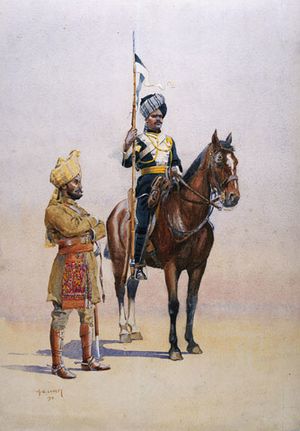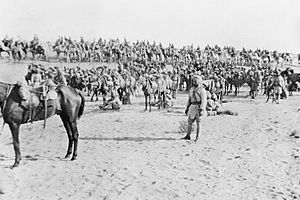Imperial Service Troops facts for kids
The Imperial Service Troops were special soldiers. They were raised by the rulers of the princely states in the British Indian Empire. These troops could fight alongside the main Indian Army. This happened whenever the British government asked for their help.
Around the year 1900, there were about 18,000 of these soldiers. British army officers regularly checked on them. They usually had the same equipment as other soldiers in the British Indian Army. Even though there weren't huge numbers of them, Imperial Service Troops fought in places like China and British Somaliland in the early 1900s. Later, they also played a part in the First World War and Second World War.
Contents
How the Imperial Service Troops Started
In March 1885, something happened that worried the British. A Russian army defeated the Afghan army near a village called Panjdeh. This village was on the border between Russia and Afghanistan, and the border wasn't very clear.
The British quickly sent soldiers from the Army of India to protect their North-West Frontier. This event, called the "Panjdeh incident," also led to something good. Many Indian rulers offered money to help if a war started. The Nizam of Hyderabad was one of the most generous.
Even though the problem was later solved peacefully, the help from the Indian princes was important. It made the British decide to create a special reserve army. This army would have about 20,000 soldiers. These soldiers would come from the armies of the Native States. The main Indian Army would train and equip them. The Native States paid for this training and new equipment.
Armies of the Princely States
The armies of the Princely States had many rules placed on them. These rules came from special agreements called subsidiary alliances. Because of these rules, the princely states' armies were mostly for parades and keeping order inside their own areas.
A British report explained it this way: "A ruler cannot attack his neighbor or fight with another country. So, he doesn't need a big army. He only needs soldiers for police work, for show, or to help the British government."
The report also said that large, unnecessary armies could cause problems for the state itself and worry others. The British government promised to protect the Native princes' lands from attacks and even from rebellions inside their own states. The British army was set up to defend not just British India, but all lands under the King-Emperor's rule.
There were other rules too:
- Forts could not be built in inland areas.
- Factories for making guns and ammunition were not allowed.
- Soldiers from other states could not join their local forces.
- They had to let the British army get supplies, set up camps, and arrest soldiers who ran away.
- They also had to accept British control over railways, telegraphs, and mail. This was seen as important for everyone's safety.
Equipment and Training
When the Imperial Service Troops plan started in 1885, the British government in India agreed to give equipment and weapons to the states' armies. This was for the units that were ready to help the British Raj when called upon.
In return, the princely states had to train their promised troops. They needed to be ready to fight alongside regular Indian regiments. To help with this, officers from the Indian Army were sent to work with Imperial Service Troops units. Special training schools were also set up for new Imperial Service recruits.
A high-ranking British officer was put in charge. He was called the Inspector-General of Imperial Service Troops. He had a team of inspectors to help train the troops and advise the military leaders of each state. Besides the units that were part of the Imperial Service, the larger princely states still kept some traditional units. These were for ceremonies, but they were much smaller in number.
Early Battles
Kashmir was the first state to send its soldiers into action. They sent two mountain artillery units. These units fought in the Hunza Nagar campaign in 1891 and later in the Chitral battle in 1895. Nine Indian states sent Imperial Service soldiers to the Frontier War in 1897.
Units from Alwar, Bikanir, Jodhpur, and Malerkotla fought in China during the Boxer Rebellion in 1901. The Bikanir Camel Corps later served in Somaliland in 1902. The British usually did not send Indian troops to the South African War (1899–1902). However, the princely states provided many horses and much equipment from their Imperial Service supplies.
The different Imperial Service units often had fancy parade uniforms. These were designed and changed by the rulers of each state. But when they went to war, they wore the plain, light brown uniform of the regular Indian Army.
Imperial Service Troops in the First World War
Before the First World War started in 1914, twenty-nine Indian states were part of the Imperial Service Troops plan. In total, there were 22,479 soldiers. This included 7,673 cavalry (soldiers on horseback), 10,298 infantry (foot soldiers), and 2,723 transport corps (who moved supplies). Smaller numbers served as artillery, engineers, and signal personnel. There were also 637 Camel Corps troopers, mostly from Bikanir.
During the First World War, 18,000 Imperial Service soldiers fought. They served in Mesopotamia, Egypt, Palestine, and East Africa. This included soldiers from the Jammu and Kashmir State Forces. The Kashmir Rifles fought very bravely at the Battle of Tanga. Other troops were defeated there by the German colonial forces. Engineers and transport units were sent to France.
Soldiers from the smaller states did not go overseas. Instead, they worked on security duties or trained cavalry horses in India. At the start of the war, many Indian rulers were very supportive. They did more than just provide their Imperial Service Troops. In September 1914, the Viceroy Lord Hardinge reported that 700 Indian princes had offered help. This help ranged from sending troops to providing hospital ships or money.
Imperial Service Cavalry Brigade
From 1914 to 1916, a special group called the Imperial Service Cavalry Brigade was part of the Egyptian Expeditionary Force. This force was led by General Maxwell. The Cavalry Brigade, along with the 10th and 11th Indian Divisions, the Bikanir Camel Corps, and three Indian Mountain Artillery units, helped defend the Suez Canal. This was at the start of the Sinai and Palestine Campaign.
The Imperial Service Cavalry Brigade included the Jodhpore Imperial Service Lancers, the Mysore Imperial Service Lancers, and the 1st Hyderabad Imperial Service Lancers. They continued to serve in the Egyptian Expeditionary Force in 1917. In 1918, these regiments formed the 15th (Imperial Service) Cavalry Brigade. This brigade was led by Brigadier General Cyril Rodney Harbord. It was part of the 5th Cavalry Division, led by Major General H. J. Macandrew.
They took part in the cavalry charge during the Battle of Megiddo. They were still fighting near Aleppo when the war ended, after advancing from Damascus.
Between the World Wars
In 1920, the Imperial Service Troops system was looked at and changed. The troops were renamed the Indian States Forces. They were divided into different groups:
- Field Service Units: These were organized, trained, and armed to the same level as the main Indian Army.
- General Service Units: These were available as a reserve force. They would be upgraded if needed.
- A third group was the militia. These could be called up for security duties inside India. However, they had less advanced weapons and equipment.
On paper, the Indian States Forces had about 50,000 men from forty-nine states. But it took time to put the new plan into action because of money and other reasons. It was not fully completed until 1939.
Second World War
During the Second World War, the Indian States or Princely states provided 250,000 men for the Indian States Forces (ISF). ISF units fought in places like Malaya, Burma, North Africa, the Middle East, and Italy. Some units also served as guards and internal security troops in India. Five ISF battalions were part of the Singapore defense when it fell to the Japanese in February 1942.
After Independence
After 1947, India became independent. Sixty-nine former Indian States Forces units joined the part of the Indian Army that went to the new Dominion of India. ISF infantry units usually became part of existing regular regiments. For example, the 1st and 2nd Patiala Infantry became the 15th and 16th (Patiala) battalions of the Punjab Regiment.
However, six ISF cavalry regiments were combined to form a new unit called the 61st Cavalry. This is still the only horse-mounted unit in the Indian Army that is not just for ceremonies. Four ISF infantry regiments and one mountain artillery unit joined the new Pakistan Army.
See also
- British Indian Army
- Regiments of the Indian Army (1903) – Imperial Service Troops




